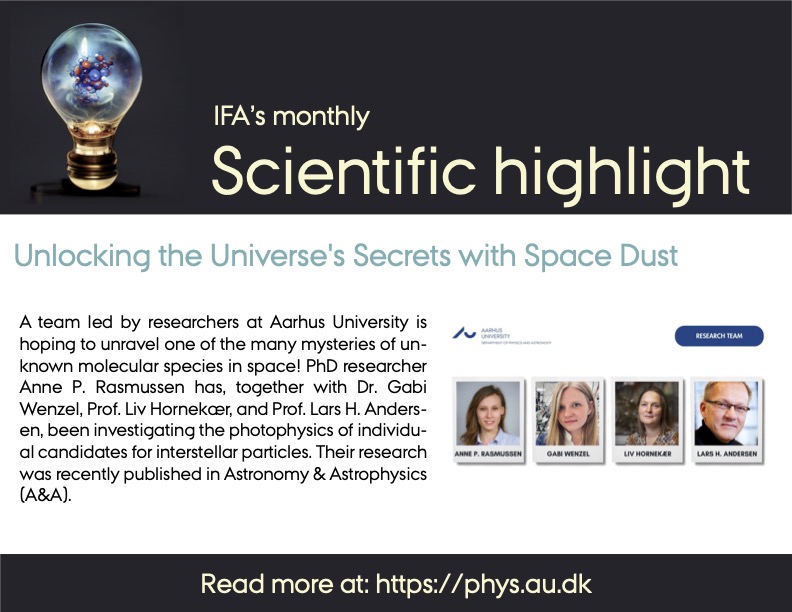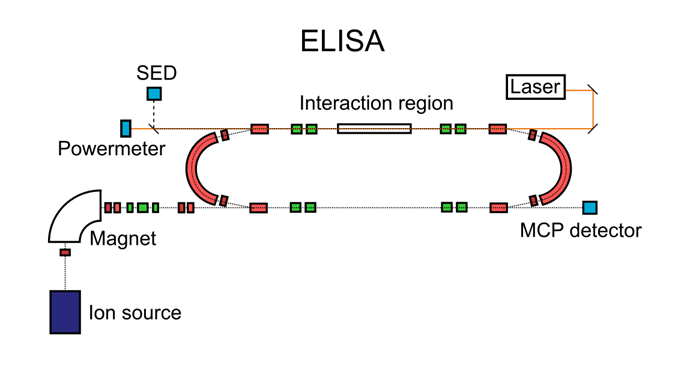Scientific highlight - october
Unlocking the Universe's Secrets with Space Dust: A team led by researchers at Aarhus University is hoping to unravel one of the many mysteries of unknown molecular species in space


PhD researcher Anne P. Rasmussen has, together with Dr. Gabi Wenzel, Prof. Liv Hornekær, and Prof. Lars H. Andersen, been investigating the photophysics of individual candidates for interstellar particles. When looking at the space between the stars, referred to in astrophysics as the interstellar medium (ISM), there is a consistent emission within the red-light spectrum, from about 540 to 800 nm, known as the Extended Red Emission (ERE). It is commonly thought that this is caused by interstellar dust, but the specific molecules and particles which might be responsible remain unknown. Rasmussen and her team believe that small organic molecules could provide a piece of the puzzle. Their research was recently published in Astronomy & Astrophysics (A&A).
The team looked at five molecules which may be contributing to ERE. One of the molecules studied is a protonated polycyclic aromatic hydrocarbon (PAH). Simply put, this is a common organic molecule which is bonded together in multiple cyclic shapes called aromatic rings. The four other molecules are oxygen-functionalized PAHs (OPAHs). This study investigated the ability of these OPAHs to absorb near-ultraviolet and visible light. The purpose of the experiment is to see if low-lying electronic states of OPAHs could match and hence possibly account for some of ERE bands.
Optics is an important part of how we study the sky and space. Collecting information about how light interacts with different particles, molecules, and gravitation adds to our knowledge of the mysteries of the universe. There are two primary ways to gather optical data from space, through emission and absorption spectra. In emission spectra, excited states of certain particles release light for us to see. In absorption spectra, the particles take in light for their interactions, leaving gaps in the total spectrum for scientists to examine. By focusing on the absorption of OPAHs, the team can learn more about the internal structure of these molecules, and how they might interact with light to contribute to ERE.
The experiment was conducted using Aarhus’ own ELISA (Electrostatic Ion Storage ring in Aarhus). ELISA allows researchers to store ions for long periods of time, as well as observe interactions between these ions with laser light.
With ELISA, the team measured the gas-phase absorption of these five organic molecules within the 200-700 nm light range. The experimental spectra were then compared to calculations performed according to time-dependent density functional theory (TD DFT). TD DFT is a theory used in physics to measure the movements of a system within a time-dependent field, such as an electric one, as in this case. Rassmussen’s team found that two specific OPAHs have broad absorption lines well within the red side of their spectrum. These absorption plateaus may be explained by low-level electronic states which, in turn, might be relevant for understanding ERE. This study shows that OPAHs may indeed be contributing to ERE in the ISM when such molecules interact with UV and visible light. In future studies, the team suggests continued research at cryogenic temperatures which provides much more precise spectroscopic fingerprints to be compared with observations of the ISM.
In summary, this research paper investigates the light absorption properties of protonated oxygen-functionalized polycyclic aromatic hydrocarbons (OPAHs), which are important molecules in understanding the chemistry and physics of astronomical environments. The study provides valuable insights into the behaviour of these molecules when they interact with light, which can help improve our understanding of the chemical interactions in space.
Read the paper here.
Made in collaboration with Science Melting Pot.
